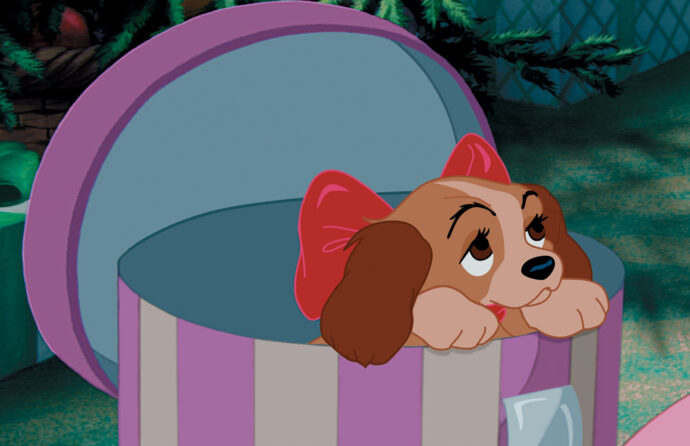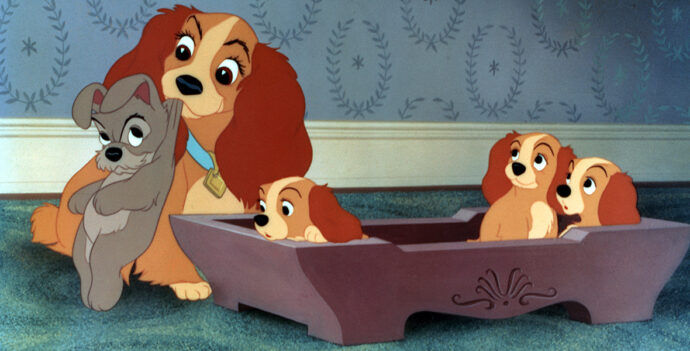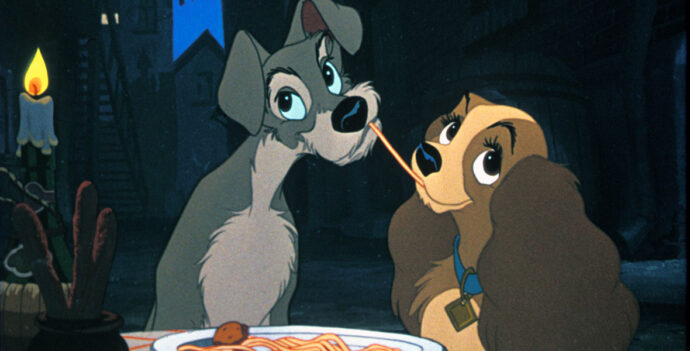Plus or Minus is a series detailing and analyzing every feature film now streaming on Disney+. It combines the unique history all these films share, their cultural impacts, and their qualities, or lack thereof. From timeless classics, to acquired hits, to DCOMs, no stone will be left unturned.
Plus or Minus returns to animation with Lady and the Tramp, another iconic feature in the Disney Animation canon. This animated tale focuses on the life of Lady, a pampered Cocker Spaniel living with two doting owners. But as she grows from puppy to adult, things begin to change. Her owners are now having a baby, meaning she is getting less attention. And after a misunderstanding, she flees the streets and meets a homeless mutt known simply as Tramp. Tramp’s street smarts, carefree attitude, and always on-the-run lifestyle is a stark contrast to the quiet and sheltered world Lady has lived in. Yet the two discover they not only have more in common than they might think, but learn important values from one another and perhaps end up in love with each other.
Close to the Heart
Lady and the Tramp served as a needed departure for Disney’s animation department. Their past few films, Cinderella, Alice in Wonderland, and Peter Pan, were all based off popular fairy tale literature. This was also true for Snow White and Pinocchio. Even the likes of Dumbo and Bambi were based off of popular books. However, what makes this stand out in particular is its heavy inspiration from true events.
Disney story artist Joe Grant had his own Lady Spaniel, who was also “shoved aside” when Grant had his first child. This gave Grant inspiration for the next Disney feature, but after Walt Disney’s initial approval, it failed to gain traction. Story ideas failed to land, as Walt felt Lady was not compelling a character. But things changed thanks to another source. A source that gave Lady a character to work off of and solidify what would become one of Disney’s most popular romance stories.
In 1945, Cosmopolitan magazine featured the short story “Happy Dan, The Cynical Dog”, which is about…well, what it says on the tin. This would soon evolve into the creation of Tramp, the cynical, mangy dog with a loner worldview that gave the needed contrast for the proper and sheltered Lady character. And after years of story development, with Joe Grant leaving Disney itself in 1949, we finally got our movie. So technically it’s based on an existing source, but only…half the story.
The Power of CinemaScope
Lady and the Tramp was also a further innovation for Disney’s animators due to the inclusion of CinemaScope. Long before the days of IMAX, CinemaScope was where people got big-screen action. Essentially widescreen, this was the first time the Disney animators used the format. Everything before was full-frame aspect ratio. At the time, with the rise of television disrupting the movie business, CinemaScope was essentially a gimmick to show something you plain couldn’t get on your TV set.
However, this is a very effective gimmick for the movie itself. In fact, it’s the main reason why the animation shines all these decades later. With the Cinemascope format, this allows for gorgeous landscapes that bring the 1910s-era small town Lady and Tramp live in to life. The backgrounds are incredible and we see so much more beauty with this improved aspect ratio.
The Cinemascope also emphasizes the viewpoints of the dogs themselves. Everything is shot from the perspective of the canines. Humans are rarely seen from the waist up, while the ratio presents a restrictive look in a world viewers are familiar with. It really does feel like the viewer is a dog. The people are towering over them and the world looks way bigger than it actually is, since we’re so close to the Earth. Even indoors locations like a house feels larger than life. These are all great artistic decisions that make this romance story so much more enthralling.

Arguably Disney’s Greatest Romance?
Of course, at its core, much of the reason why Lady and the Tramp has maintained its classic status is the relationship between Lady and Tramp. In many ways, it is arguably one of the most unique relationships within the Disney canon. The classic Disney romance is one we all know. It’s a good template for sure, but Lady and the Tramp dares to be realistic.
For starters, there’s no love at first sight. If anything, their initial interaction is an unpleasant one that shows how different their worlds. But like real couples, their progression to love is a slow one. One that is reliant on multiple dates, several conversations, and only one true moment where the characters realize they are in love. While of course romanticized and technically over the span of a day or two, it’s refreshing to see something feel relatively realistic. This is also helped by the strong chemistry given by the voice actors and the dialogue.
Better yet, the film is also smart in showing that Lady and Tramp’s relationship makes both parties learn something about themselves. Lady, a naive and sheltered woman, learns about how wonderful the world is and how to stand up for one’s self and become independent. Tramp, a man who yearns for independence and no close relationships, discovers how wonderful it is to be with somebody. And that his actions can and do have consequences towards others. It’s perhaps not revelatory, but still very mature and compelling.
If anything, it feels ahead of its time when it comes to Disney. Some of the best Disney romances, from Beauty and the Beast to Aladdin to The Princess and the Frog to Tangled, all follow this template. Two polar opposites who don’t seem remotely compatiable. Yet through the course of the story, they learn from one another and both grow as people from each other. And this is probably the strongest in terms of pacing and dynamic.

It is Racist Though :/
Unforunately, despite the strong and progressive romance, this has its 1950s datedness. Everybody knows about the “We Are Siamese” musical number. And while not the most offensive, it’s still uncomfortable to hear these offensive accents coming from the voice of a white lady. There’s also a chihuahua with a funny Mexican accent and another chihuahua with a long and funny name. It’s very not fun.
But like with many of Disney’s classic titles, they can be…ignored. Or at least I can ignore it, though I acknowledge it’s different from person to person. There’s a lot more to these films than these dated elements and are entertaining watches today. There’s also some needed historical context, especially for the younger viewers watching for the first time.
Plus or Minus?
Watching this decades later, already a fan of Disney’s Silver Age, I was floored by how good Lady and the Tramp really was. It’s not only drop-dead gorgeous from its art direction to cinematography, but has an absolutely perfect romance. It’s a love story that’s about real love. Making sacrifices, growing from one another, finding what really matters. And it’s through two adorable dogs in 1910s Americana. It’s stunning to watch and charming and endearing to see this story unfold. Between Plus and Minus, Lady and the Tramp is an incredibly strong Plus, and another strong showcase of how great those Disney animators and storytellers truly were.
NEXT TIME: We venture back into True-Life Adventures with The African Lion. While the other documentaries were pretty medicore, could this be the one that turns things around?
